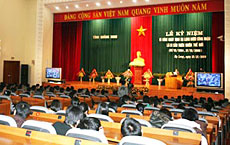The 15th anniversary of Halong Bay’s recognition as a world natural heritage site was celebrated in the northern coastal province of Quang Ninh on December 15.

Speaking at the ceremony, Vice Chairman of the Quang Ninh provincial People’s Committee Nguyen Van Doc said that Halong Bay’s status as a world natural heritage site has helped more people in the world know Vietnam. The Ga Choi (Fighting Cock) Islet on the Halong Bay was selected as a symbol of Vietnam’s tourism sector in 2000.
The bay, which was twice recognised by the United Nations Educational, Scientific and Cultural Organization (UNESCO) for its natural beauty in 1994 and geomorphic characteristics in 2000, is also among the top of the list in a campaign to vote for the world’s seven new natural wonders by the NewOpenWorld, he said.
Quang Ninh Province always considers the preservation of Halong Bay as one of the top priorities in its socio-economic development strategy. Nearly 80 investment scientific research project on the bay have been carried out at a total cost of more than VND100 billion. They include an environment management project and a community-based natural resources circulation assistance project funded by the Japanese International Cooperation Agency (JICA), a flora system research project funded by the International Union for Conservation of Nature (IUCN), a feasibility study project on a Halong Ecological Museum sponsored by the United Nations Development Programme (UNDP) and a project to raise the awareness of marine protection by Fauna and Flora International (FFI).
Halong Bay welcomed almost 2.2 million tourists in the first 11 months of the year 2009.
The bay, with a 120km stretch of coastline, is part of the Bac Bo (Tonkin) Gulf in the northeast of the country. Covering over 430km², the bay is dotted with 1,969 limestone islands that rise spectacularly from the sea, and is renowned for its diverse geographical features, such as a unique system of island caves and karst topography.
Geographical attractions aside, Halong Bay is home to a diverse ecological system that includes mangrove forests, tropical forests and coral reefs that are inhabited by more than 1,000 species of fish and marine life.
The islands are also home to many species of birds, bantams, antelopes, monkeys and iguanas.
Scientists have proved that Halong Bay is one of the cradles of ancient Vietnamese people with three consecutive prehistoric cultures that dated back to 18,000 years.